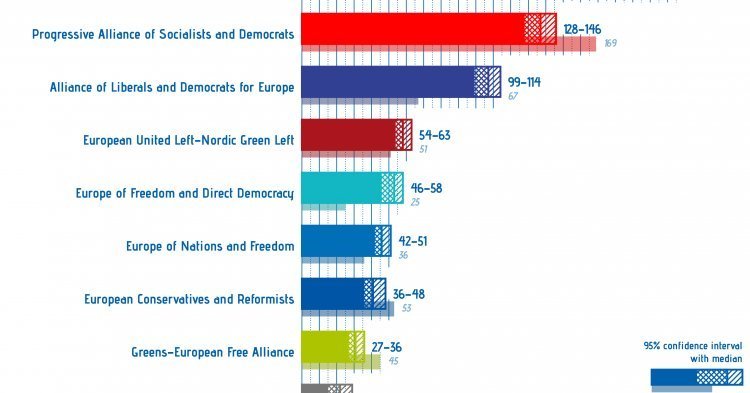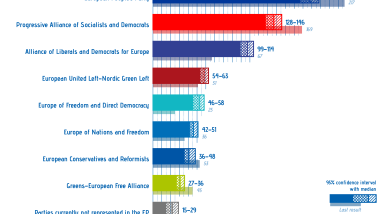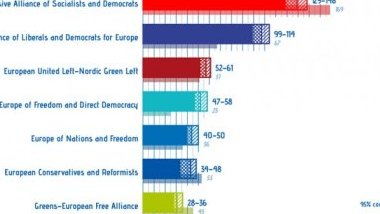The composition of the Parliament will change considerably because of Brexit and strong swings in the vote in the 27 remaining EU member states. Incumbent Jean-Claude Juncker’s liberal-conservative EPP group remains the strongest force in the European legislative. Altogether, a large majority of around 80 percent of Europeans stand behind pro-European parties.
EPP keeps the Commission presidency
The current projection by Europe Elects expects Jean-Claude Juncker’s liberal-conservative EPP group to remain the strongest force despite massive seat losses. According to the prognosis by the international team of electoral analysts, the EPP group will only have 179 MEPs instead of 217.
If the Spitzenkandidaten system is applied, the Commission President will come from the EPP’s ranks. However, the incumbent Juncker will no longer stand in the 2019 election. Potential candidates for the post among EPP’s ranks are the Commission’s current Brexit chief negotiator Michel Barnier, and the former Finnish Prime Minister and current Commissioner for jobs and growth, Jyrki Katainen.
Social Democrats and Brexit: End to the dream of finishing first
Likewise, the S&D group will greatly shrink from 189 to just 141 MEPs. Vote losses in continental Europe (28 MEPs) and the disappearance of the British Labour Party through Brexit (20 MEPs) are contributing factors to this. Without Brexit, and considering the strength of Jeremy Corbyn’s Labour Party, S&D could have had a chance to inherit the role of the biggest party in the European Parliament and to gain presidency of the Commission through Spitzenkandidaten. Brexit has killed this possibility, given that EPP is not represented in Great Britain or Northern Ireland, and therefore does not need to fear direct seat losses because of Brexit.
Is the liberal ALDE going to split?
Guy Verhofstadt’s liberal ALDE group has an uncertain future ahead. Provided that Emmanuel Macron’s La République En Marche party joins the ALDE group, the number of ALDE MEPs would nearly double despite the disappearance of one liberal MEP from the UK. The group would grow from its current size of 68 to 113.
Whether Macron’s party will in fact join the ALDE group is, however, unclear. It appears possible that Macron will seek to found a parliamentary group of his own, one which would include the federalist wing of the current ALDE group. According to the classification of EU scholar Manuel Müller, liberal parties from France, Spain, Romania (USR, but not ALDE), the Netherlands (D66, but not VVD), Belgium, Sweden (L, but not C), Austria and Luxembourg would belong to Macron’s group. Following this assessment, Europe Elects predicts that Macron’s group would consist of 56 MEPs. This result, however, does not include MEPs belonging to parties within S&D, Greens/EFA and EPP that have already hinted at a shift to Macron’s group. Among these are Italy’s PD which currently belongs to the S&D group. The moderate, anti-federalist wing of ALDE would be left with only 57 MEPs, with parties such as the Czech ANO, the German FDP and the Dutch VVD.
Brexit hurts the national-conservative ECR through the Tories’ disappearance
The national conservative ECR consists primarily of ultra-conservative, Christian fundamentalist parties and anti-federalists like the German Bernd Lucke. The group would lose its status as the third-largest group in Parliament. Instead of the 74 it had in 2014, it could only dispatch 42 MEPs to Brussels and Strasbourg. Above all, the ECR group suffers from the disappearance of the British Conservatives with Brexit.
One cannot rule out the Eurosceptic conservative group’s complete evanescence from the Parliament. In order for a group in the European Parliament to be recognised, it must have 25 MEPs from seven countries. The current seat projection does give the ECR 42 seats from ten countries, but in the light of current surveys it is unclear whether deputies from five of these countries can win a seat in Brussels. This means that the ECR has to expect that it won’t manage to meet the number of countries required for a parliamentary group.
Populist EFDD group facing its end
The populist EFDD (58, an addition of 14 compared to current seat numbers) and the left-wing GUE/NGL group (61, an addition of 9) would be clearly stronger than ECR. Behind the liberals, they are engaged in a true battle for the fourth place, where the left-wing group has increased its lead over EFDD in the past month.
Unlike the left-wing group, which can send MEPs to the Parliament from 13 countries, Beatrix von Storch’s EFDD can only hope for support from seven countries. While it seems technically possible, in reality it is unlikely that the Italian Five-Star Movement supports the group. Ideologically, the 5SM is clearly closer to pro-EU positions than what EFDD membership would suggest. This was displayed by the Five-Star Movement’s failed attempt to become a part of the ALDE group. Furthermore, the May prognosis by Europe Elects predicts only one seat for EFDD from Estonia. Therefore, the continued existence of EFDD in its current form seems unlikely after the 2019 European elections. Many EFDD MEPs are currently flirting intensively with Marine Le Pen’s far-right group. Among these are, inter alia, the German AfD and the Swedish Sweden Democrats (SD).
The far-right ENF is not disappearing
Marine Le Pen’s far-right ENF group will, according to the current prognosis, reach 47 seats instead of the current 37. These would come from eight countries altogether. This is on the assumption that Spain and Slovakia would each send one MEP to ENF. However, if both of these candidates fail, the end of EFDD could save ENF, as some of the orphaned parties could change to the ideologically closest group: ENF.
Greens/EFA remains a small group
Pirate parties, separatist regional parties, the Lithuanian farmers’ party LVŽS and the Greens compose the Greens/EFA group in the European Parliament. This union, at 32 seats (-14) from 12 countries, continues to exist despite the loss of six British MEPs. 26 MEPs from nine countries would come from the Greens, three from the Czech Pirates, three from the Lithuanian farmers’ party, and one from the Catalan ERC.
Twelve MEPs (-8) would remain without a group among the non-inscrits. These include left-wing and right-wing extremist parties, and Martin Sonneborn’s satire party, ‘die PARTEI’, which has one seat.
Taken together, 20 MEPs belong to parties currently not assigned to any group. Concretely, this means members from Croatian Zivi Zid and MOST parties, FdI in Italy, Kukiz’15 in Poland, USR in Romania, Sme Rodina in Slovakia and LMS in Slovenia. MOST, USR and LMS are aligned towards the centre. On the other hand, FdI, Kukiz’15 and Sme Rodina are at the right end of the spectrum.
Vote shares
Looking at the underlying distribution of votes, the liberal-conservative EPP group, with 20.5 percent of the vote Europe-wide (unchanged compared to the previous month), would only be the second-biggest party. Here again, the UK is worth considering. The social democratic S&D group would win back the first place in terms of votes. 21 percent (+1.5) of voters would give their votes to the centre-left group in the European Parliament.
Infogram
The liberal ALDE group, among which Emmanuel Macron’s LREM is counted here, currently reaches 13 percent (-1). The national-conservative ECR group receives 10.5 percent (+0.5). The populist EFDD group of the Five-Star Movement and UKIP stays at eight percent, at a strong position in a historical perspective. The electoral success of Lega in Italy still buoys Marine Le Pen’s ENF group, now receiving 7 percent (+0.5) support Europe-wide. The left-wing GUE/NGL reaches 8 percent, while the Greens/EFA group remains stable at 4.5 percent. Parties in the NI group get 2 percent.





Follow the comments: |
|
